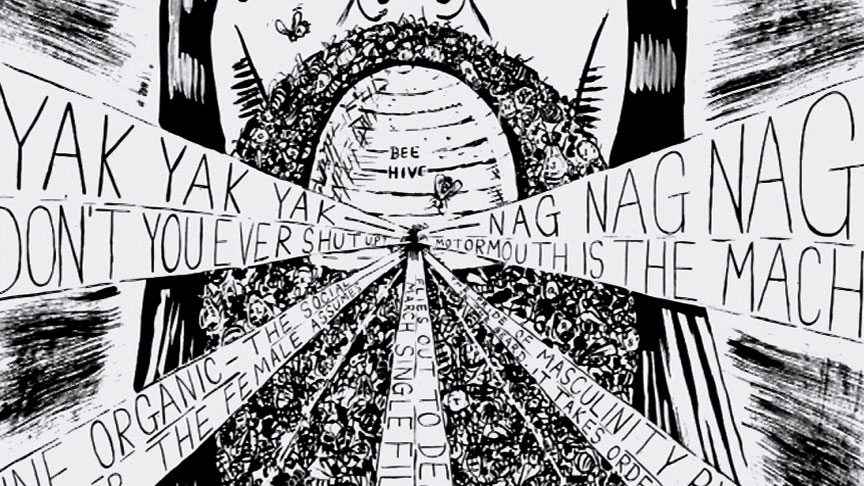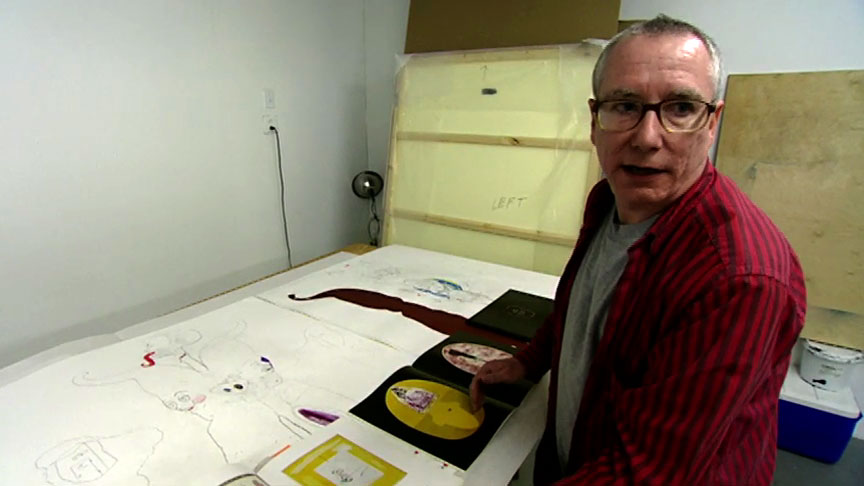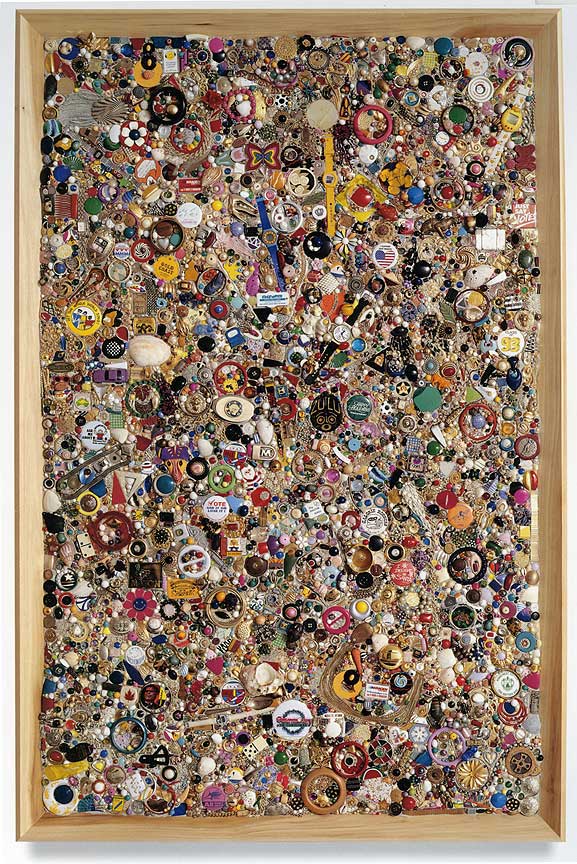Interview
Language and Psychology

Mike Kelley. Bee Beard, detail, 1985. Collection of Barry Sloane.
Artist Mike Kelley discusses psychological theories, beauty, and the sublime.
ART21: How much do psychological theories factor into your work?
KELLEY: I don’t think it’s something that’s there all the time. In certain projects it is. In the Uncanny project, it’s there because Freud wrote (really) the only essay on the uncanny, so I used that as a reference point.
I can’t say that I’m particularly invested in Freudian ideas, though I do really like Freud’s writings; I think they’re really beautifully written. A lot of psychoanalytic writings are just not very interesting to read, and Freud really is interesting to read. So, I like him as a writer, but in terms of the theory—so much of that theory’s been absorbed in the popular culture. To get into the nitpicky little details about all the squabbles between the analysts and all those different psychological theories—I don’t want to get to that. That’s far too complicated, and that’s not my focus, really. I tend to use writers and theories for my own ends. And generally they’re poetic ends. I tend to use psychoanalytic writing or psychological literature that way.
I’m actually a big fan of the writings of Ferenczi, who’s a contemporary of Freud, and also Reich and Lange, whereas Lacan doesn’t interest me very much. I just don’t find the writings speak to me as literature. I tend to really like that psychological and psychoanalytical writing tries to tackle basic human motivations and problems. Also the way that those people write about sublimation—how do I describe this—the fact that one idea can be substituted for another or block another. That’s very much like metaphor, and that’s very much, to me, like art. I really think art’s about representation. And I don’t believe in nonobjective art; I don’t think there’s such a thing. That’s not to say that I’m a realist, but I think all things operate on multiple associational levels. That’s how people look at the world. So, I’m drawn to discourses that are interested in that. Psychoanalytic writing tends to be about people’s daily problems; it’s more rooted in reality and daily life. I’m more drawn to it than abstract philosophical writings.
For example, in my paintings, I was thinking of just taking random quotations from Ferenczi, as if that explained the paintings. Ferenczi has a lot of fantastic little snippets that could be taken out of context. It’s not serious; it’s just meant to throw the whole thing into some kind of light. It provokes the viewer to project into it in a more controlled way than they would naturally. I’ve also been reading recently—oh, what’s her name, the British psychotherapist who did a lot with children and play theory? Melanie Klein. I’ve been reading a lot of Melanie Klein and thinking of making some sculptures particularly related to her ideas of play therapy—but in a musical context. That genre of writing is one of my favorite genres. In fact, it’s taken the place for me in my reading over literature, because I don’t find much literature that interests me nowadays. When I was younger, I was really a bookworm and read a lot of literature. But I don’t get pleasure from it anymore, whereas I still get pleasure from reading “shrink” books.

Mike Kelley in his studio, Los Angeles, 2004. Production still from the Art in the Twenty-First Century Season 3 episode, Memory. © Art21, Inc. 2005.
ART21: Can you talk about your own writing?
KELLEY: When I was younger, all my writing was generated for performance work. So, it was writing that had to have a kind of flow. I was very much influenced by writers like Raymond Roussel, Samuel Beckett, Gertrude Stein, and Thomas Aquinas. There’s always a sense of presence, but at the same time, things shift—like in Aquinas’s “proofs” or how reiteration is used in Beckett or Stein. A lot of my writing at that period was very associational but trying to be structured in a way, where ideas could be a stream of consciousness but be simple enough to flow, one to the next. Where you could flow and contradict yourself but the audience—because of the durational aspect of the performance—wouldn’t remember. They’d remember the content, but they wouldn’t remember that things change. And that really interests me about older forms like oral forms.
I started doing more critical writing in the ’80s, when I was very unhappy with how my work was being written about and how other artists that I respected or had some association with were being radically misrepresented in the art press. But now I’ve tired of that. I don’t feel like I need to be the voice of my generation or my group, and I don’t care so much about art world politics. So now, I’m much more interested in getting back into creative writing. This project [Day Is Done] is very much a way for me to get back into writing. And because I don’t have the time just to do it, I have to work it into my work, somehow—like music. I didn’t have time to play music anymore, so I had to make a project where I forced myself to make music. That was the reality of it; otherwise I wasn’t ever going to get to do it. But I still, on occasion, write catalog essays or things like that. When I remounted the Uncanny exhibition, I had to write a new preface for that because the art world had changed a lot in fifteen years, and I needed to update my thoughts. But it wasn’t something I really wanted to do; it was something I had to do.
ART21: What about your books?
KELLEY: I’ve just published, in the last two years, two books of my essays and informational writings about my work. What hasn’t been published are all the performance texts and writings for video. That’s the project I want to do next, but that’s massive because I’ve written a lot more of that than I have critical texts.
ART21: Is there a limit to what you would include?
KELLEY: Oh, for sure. There are certain kinds of things that I wouldn’t publish, like song lyrics, because they’re just so stupid; they don’t make any sense outside of the musical context. But I would rework the performance texts for publication. I think they can function as a kind of poetry.

Mike Kelley. More Love Hours Than Can Ever Be Repaid and The Wages of Sin, 1987. Stuffed fabric toys and afghans on canvas with dried corn, wax candles on wood and metal base; 90 × 119 1/4 × 5 inches. Whitney Museum of American Art, New York; Purchase, with funds from the Painting and Sculpture Committee 89.13a-e. Photo by Sandak/Macmillan Publishing Company, photograph copyright © Whitney Museum of American Art, New York.
ART21: Are the titles of your projects important?
KELLEY: Very much so. Often my titles are quite lengthy, and they’re meant to be descriptive. They’re trying to be clear, trying to say what it is, but at the same time they reveal aesthetic clashes, or their wordiness gets to the point of incomprehensibility. I like poetry, for example, in which the language can fall into pure sound. Yet there’s always this tension between the musicality of the language or the fact that it falls into rhythm, into something you find in really complicated language, like theory or legalese. And I’m drawn to that kind of language. A title like Extracurricular Activity Projective Reconstruction—that’s what it is. When you say it, it’s hard to take it in; it’s a mouthful of words. But it’s not meaningless—that’s what it is. Not all the titles are complicated like that, just some. Some are really simple.
ART21: How have critics understood your work?
KELLEY: I was associated with this so-called Abject Art movement, in which notions of failure came into play in the discussion of art. And because a lot of my work looks towards so-called low forms, like folk art or lower-end mass culture, critics of my work tended to confuse my use of that with some kind of investment. That this is some kind of “blue collar” aesthetic. Well, I might come from that, but I have no love of it.
The art world’s changed a lot because recently such things have found a place in the art world—when fifteen years ago, you’d never see in every gallery in New York some kind of mass-culture referent. Now every gallery has such things, and this discussion of slackers has become a positive term rather than a negative term. This kind of discussion doesn’t interest me whatsoever, because who defines these things? I can’t talk about it so abstractly; it’s meaningless. So, I don’t feel like getting into specifics about that, relative to other artists’ production.
ART21: What about the idea of beauty?
KELLEY: This was a really big topic in contemporary art. The so-called New Beauty camp—art becoming beautiful again. I think they’re talking about conventional ideas of beauty, and I’m more interested in the sublime. I think it’s a kind of neo-conservatism that fits right in with Republican ideology. It’s backward-looking, and I’m not interested because the New Beauty is old-fashioned beauty, as far as I see it.
ART21: What do you think is beautiful?
KELLEY: I think what I make is beautiful. I think it’s beautiful because terms and divisions between terms are confused, and divisions between categories start to slip. That produces what I think of as a sublime effect, or it produces humor. And both things interest me. When you use the word sublime, traditionally it’s associated with metaphysics. It’s a nineteenth-century usage, like the sublimity of a mountain that becomes like nature and God. I don’t mean to evoke it in that way. I’m interested in a less elevated beauty.

Mike Kelley. Memory Ware Flat #13, 2001. Paper pulp, tile grout, acrylic, miscellaneous beads, buttons, and jewelry on wooden panel; 70 × 46 × 4 inches. Photo by Nic Tenwiggenhorn. Courtesy of Jablonka Galerie, Cologne.
ART21: Can you say a little more about the sublime?
KELLEY: Well, like I said, I think that kind of discussion of the sublime is a nineteenth-century metaphysical discussion, like Edmund Burke or the American Transcendentalists. And of course, that’s not where I’m coming from. For me, psychedelia was sublime because in psychedelia, your worldview fell apart. That was a sublime revelation, that was my youth, and that was my notion of beauty. And that was a kind of cataclysmic sublime. It was very interiorized, it wasn’t about a metaphysical outside; it was about your own consciousness. That’s my starting point of the sublime, and I’ve had to take that into a more conceptual sphere, which is perhaps an analytical sublime. Like, how do you produce a sublime effect? Preaching is a production of sublime effect. Poetry is a production of sublime effect. Hypnosis is the production of sublime effect. And those are all examples of it, produced through language. I think you can also produce it through image—image clash, image resonance, things like that.
ART21: When did you know you wanted to be an artist?
KELLEY: I knew by the time I was a teenager that I was going to be an artist; there’s no doubt about that. There was nothing else for me to be. I didn’t even want to be the other things that at the time were outside general culture. I didn’t want to be a rock musician; I wanted to be an artist. And I think the reason I chose it was that, at that time, it was the most despicable thing you could be in American culture. To be an artist at that time had absolutely no social value. It was like planned failure. You could never be a success. And the fact that I’m now a professional artist? At that time, it seemed like a contradiction of terms. I came from a milieu in which artists were despised, whereas rock musicians and drug dealers were—you know—hipster culture heroes.
This interview was originally published on PBS.org in September 2005 and was republished on Art21.org in November 2011.



